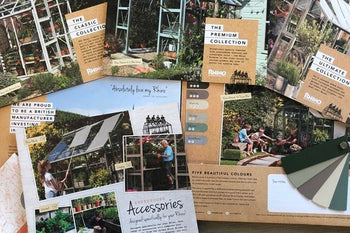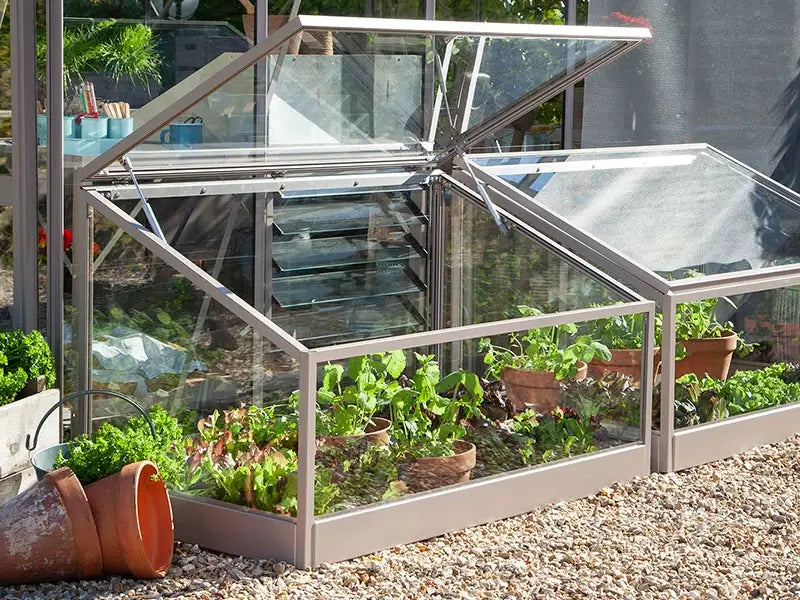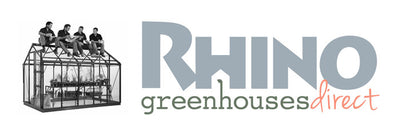Request a Brochure

The days are noticeably much shorter now and the flowers have decided to gently ease their way out of the spotlight and start bedding down for the winter (perennials and biennials) or die off entirely (annuals). They won’t give up without a fight though and I can pretty much guarantee that they will all hold on for as long as they can - when I look out the window I can still see Dahlia stems stretching up to the sky. How is it that the roses are still in bud and trying to flower They are amazing and wonderful beacons of hope.
After a few concerted weeks of effort and timeliness, the greenhouse is currently bursting with seedlings. Much of this is thanks to my fabulous friend, Sue who has been fantastic with sowing, pricking out, potting on, and providing a morale boost. Several dozen trays of seedlings can feel quite overwhelming and daunting as a solo task!
Because I find it hard to resist, I have just sown a few poppy seeds, which now risk being very leggy! But I do love a challenge. I also have sweet peas which need sowing, but they should be OK - I hope... If you'd like to find out what else you can be sowing between now and spring, you can find a monthly guide here.

Image: Sue potting on Cornflower Seedlings into 4-inch pots
Sowing, Potting On and Planting Out Flowers in Autumn
Seed sowing this autumn has been fascinating and very successful. I have sought expert advice to advance my own greenhouse growth and to share with all of you. Wherever you are with your autumn growing, some of the following may be of use.
-
Seeds Grow Better Together
Seeds love company, so this year I have been sowing en masse in seed trays. Like animals, plants produce hormones that help drive activity, and a hormone called Gibberellin is responsible for germination. When seeds are sown in proximity, the presence of this growth hormone helps to stimulate more reluctant seeds too, achieving an increased germination percentage.
I have been absolutely stunned by my germination rates this autumn, which have far exceeded my expectations. The only downside is that I cannot bear to throw away the surplus seedlings and have potted on far more than I need.
Image: Rhino Seed-Tray Rack (Featured: Norfolk School of Gardening)
-
Pot On Promptly
Once your seeds have germinated, wait for the first true set of leaves to grow. This refers to the leaves that come after the embryonic leaves (cotyledons) and are likely to resemble the leaves of the adult plant more clearly. As soon as the seedlings have one or two sets of true leaves, separate them and transplant into 2-inch modules, using potting compost which is warmer and softer than the seed compost. By doing this early, your plants are likely to achieve more stable stems and better root growth. Root growth is the most important thing at this time of year and they need space to develop, so giving them individual pots/modules will make all the difference. Leave them in a seed tray too long and the seedlings will suffer: roots get tangled together, causing headaches for transplantation, and stems can get leggy as they grow out and away from each other in competition for light.
Having said that, sometimes you need to go on a little faith. I have something nibbling some of my seedlings and I could not understand why the larkspur were so short with no leaves. After potting on they have all developed leaves thank goodness – I still haven’t found the culprit though, which now seems to be nibbling at the Ammi.
-
Always Water From the Bottom
It is very important that seedlings be watered from the bottom, never the top. Root tips are very clever in the way they adapt and respond to their environment, so they will grow in the direction that water comes from - this is the tropism effect that also causes stems to lean towards sunlight. So, if you water from above, the roots will push up towards the surface where it is dry and cold. We want the roots to grow down where it is warm, and to better anchor the plant in place for a stronger plant.
-
Be Wary of Over-Watering
The Achilles' heel of many gardeners, over-watering is so easily done and very detrimental to plants. In our eagerness to care for them, we can kill them with kindness. In cold weather, this is even more of a problem, as the heat of the sun is not around to speed up transpiration/evaporation inside the greenhouse, meaning over-watered seedlings will soak in stagnant water for a long time if left untended. I find it very difficult to judge, but drier is better than too wet, as you risk losing the seedlings to rot. Check them every day if you can.
-
When Roots are Protruding, It is Time to Pot On
If you've followed the advice above, you should eventually start to see a nice mass of roots when you tease the plant away from the module and some roots starting to come out of the bottom. Once roots start appearing at the base, you can be quite confident that you have a healthy plant that's ready to grow more.
Pot your seedlings on into 4-inch pots - don't be tempted to go bigger because the plant will tire itself out trying to fill the space. Remove carefully by pushing up from the bottom and popping out the whole plant intact. With any luck, the roots will be nicely clumped together, carrying all the compost with it. Avoid disturbing the roots as much as possible - it is all about healthy root growth now.
Image: Cornflower seedling with 6 months' root growth.
-
Use a Coldframe
Once in pots, they go outside into cold frames and when the roots have filled those 4-inch pots, they will be planted out. Coldframes are a great transitional place for young plants that need bringing on and acclimatising to a harsher environment. Plants sown and potted on during spring and summer will become stronger plants if given the opportunity to get used to cold weather. If kept inside the greenhouse throughout their young life, they may eventually struggle later.
Last week (October), we planted out Sweet Rocket, Cornflowers, Wallflowers, Foxgloves, Marigolds and Honesty. Some of these have been growing in their pots since spring as they are biennials.
-
Keep Insurance Seedlings Safe
It is very possible that some plants put outside will not make it through the winter, so I have kept back some pots in the greenhouse just in case. Flower seedlings do not always like cold wet winters and can be susceptible to rotting away, but I thought it was worth a try. It is all about experimentation!

Image: A full house of seedlings in the Rhino Greenhouse this month
All my 2-inch modules with their seedlings, are racked up in the greenhouse and will now be nurtured/cosseted through the winter. If I can transplant any into bigger pots I will but they will need regular checking for good root growth.
Next time I will show you what to do with ranunculus corms and how to get a succession of them growing from spring through to summer. I have just received mine and really need to get them going.
For now, though, go and pick yourself a final bouquet with some lovely autumn foliage.
Happy flowers xx

Image: October Flowers - Final bouquets of Dahlias, Anemones, Helianthus and Salvias
Want to grow your own cut flower garden?
A Rhino Greenhouse is the perfect environment for all your plants throughout the year.







